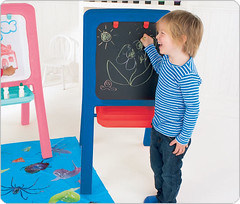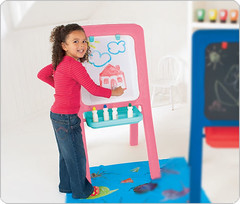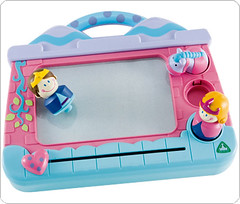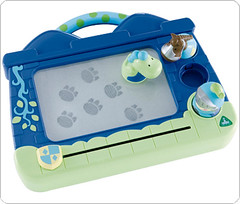It seems that Early Learning includes one important element which takes away the fuzzy warmth of the brand for me. Along with developing fine motor skills or hand-eye coordination, ELC seems determined to teach and reinforce traditional gender stereotypes in the most obvious way, starting with blue and pink segregation and going on to limiting types of toy by gender. Someone has devoted considerable time to assessing which of their toys are, and are not suitable for little boys and girls, and we are talking little, here, from birth onwards.
I won't even mention the boy-dressed-up-as-doctor, girl as nurse which they repeat faithfully in their dressing up gear for kids. The boy-doctor is even taller to emphasise his authority.
I'll rein myself in to just two issues.
First the blue/pink divide. You want to buy an easel for your 2 year old to do some chalking or painting at. The main thing about the easel: whether it's blue or pink. What is that teaching very young children? They quickly have to learn to identify with one or the other, and the spiral into princesses and mermaids versus pirates starts here.
If you search for arts and creativity toys for 2-3 year olds, boys versus girls, ELC tells you that it is OK for girls to have blue or pink variants, but it is not OK for 2 year old boys to have a pink art centre, pink plastic table, pink wooden table, a messy mat depicting flowers rather than bugs, a pink height chart or a pink bookcase. For them, it is blue only.
So in more gender neutral categories like art, girls just have additional girly versions of things, which are forbidden to boys. Boys are narrowed into blue, and girls are conditioned towards the next stage of princessdom.
In the next stage, there are attempts to steer boys and girls towards gender appropriate toys. In the dolls section, there are twice as many toys deemed suitable for girls as boys, and the reverse is true in the construction section.
It still starts young, though. It is not OK for 2 year old boys to have a play sewing card, but it is ok for girls. It is not OK for girls to have the dinosaur adventure set or the pirate cove. It is not OK for boys to have any dolls apart from rag dolls or dolls linked to an activity (that come with a highchair or bed). Baby dolls are out. It is also not ok for girls to dress as a pirate, doctor or astronaut, or to have most of the Thomas the Tank engine trains, only a basic selection, or have the wooden garage set.
I'm not even going into the genders of the children showed playing with the toys, you can guess.
From 2 years old, girls can only have 13 of the 19 construction toys. The ones deemed unsuitable are the Bosch workbench, build your own vehicle, hammer drill, meccano easy and mechanics and the Build it Up. The bigger, more active toys where you really build something.
So if you want to gender-condition your child young, ELC is a great place to buy toys. n the 1-2 year old section, boys and girls even have their segregated colour scribbling pads, blue for boys, pink for girls, just in case they're not sufficiently conditioned by the time they reach 2 years old to ask for the correct colour of easel.
And in case you want to start even earlier, there is the same blue versus pink version of 'buggy driver', a little steering wheel that fits on a baby's pram for them to play with (suitable for conditioning gender stereotypes from 3 months)
The swim toys range lays it on particularly thick: you are either a mermaid or a pirate, and that is that!
What hope is there of our children really having equality of opportunity when developmental toys intended for such very young kids are already pushing them firmly into these little boxes?
ELC has lovely creative toys, but the gender stereotyping is so insidious that I am scared to buy anything from them except crayons.



